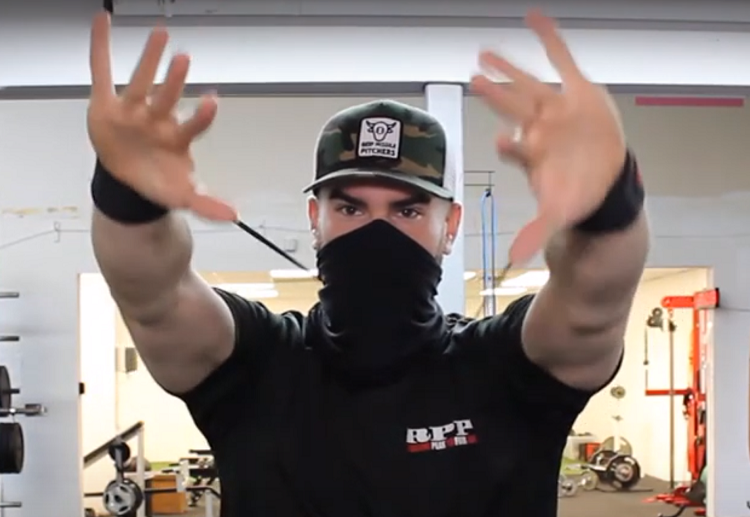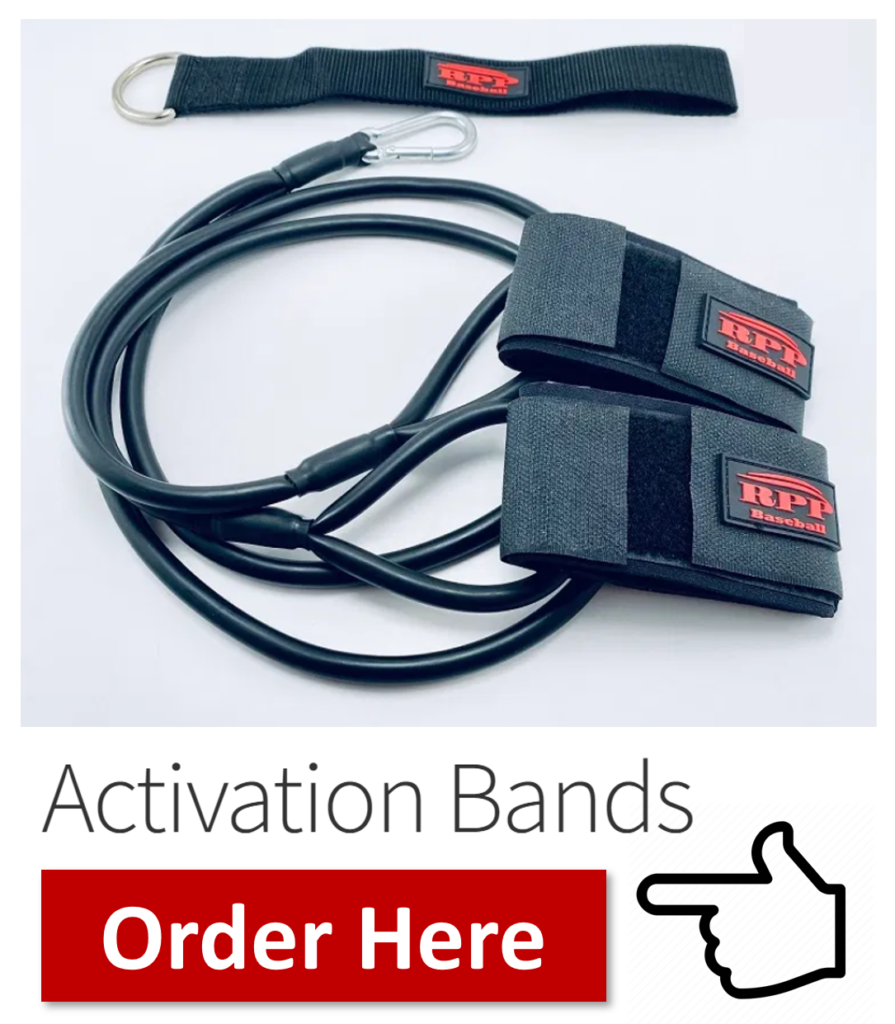
There is certainly no shortage of pitching bands and baseball band exercises for pitchers. There are actually so many that it can make your head spin. We use several baseball band exercises for pitchers as a part of our pre-throwing routine and over the years we have refined them down to what we believe to be the min / max of what you should be doing.
There are a handful of topics to consider when doing band workouts. I recognize we have previously reviewed these in other articles, but they are worth mentioning here again:
-
-
- Purpose of baseball band workouts – Unfortunately, at some point along marketing slogans began to promote baseball band workouts as a strength training tool for pitchers. Let me say this loud and clear… “Resistance band work should not be considered strength training”. While there is some degree of strengthening that can be done to the anterior and posterior cuff and shoulder musculature in the off-season with band work, it is primarily a great way to increase blood flow and activate the primary shoulder and cuff musculature that are specific to the throw.
-
- Baseball band tension – Using too heavy of a band resistance when performing baseball band workouts and activation can do more harm than good by creating poor movement patterns as well as activating the bigger muscles such as the lat. This is definitely not what we’re looking for during pre-throwing activation. Instead, band work should address the accelerators (int rotators), as well as the decelerators (posterior cuff) along with the smaller stabilizers.
-
- Volume – Most pitchers do an excessive amount of baseball resistance band work looking for that “burn” that is associated with strength training. The problem is, during the in-season, throwing is strength training for the cuff. So, whether before a game or before a pen, too much band work can put a shoulder into the 3rd inning before you’ve even thrown a single pitch.
-
- Proper form – Like all things related to training, proper form is paramount to make sure pitchers are doing them properly and activating the correct muscle groups. The videos below represent what we believe to be the “big players” when getting ready to throw.
-
Recommended List of Baseball Resistance Band Exercises for Pitchers
-
- IR @ 0 Degrees
- ER @ 0 Degrees
- IR @ 90 Degrees
- ER @ 90 Degrees
- 1- Arm Rev Fly
- Tricep Ext. w/Pronation
- Retraction to Low Row
Now let’s review each. The first 2 drills prepare the pitcher’s shoulder for both acceleration and deceleration, respectively.
1) IR @ 0 Degrees
Why? The pitcher’s subscapularis facilitates internal rotation, and helps depress the humeral head against the glenoid assisting in good “ball and socket congruency”.
Form – Keep elbow “pinned” to the side to avoid any excess movement. A towel may be used to keep the shoulder a bit more in the scapular plane and can be squeezed prior to each rep to further activate the internal rotators.
(IR @ 0 Degrees)
2) ER @ 0 Degrees
Why? Performing external rotation while the pitcher’s shoulder is adducted (zero degrees) focuses more on the infraspinatus and is usually performed prior to ER @ 90 degrees.
Form – Keep elbow “pinned” to the side to avoid any excess movement. A towel may be used to keep the shoulder a bit more in the scapular plane and can be squeezed prior to each rep to further activate posterior cuff.
(ER @ 0 Degrees)
The next two take the first and second drill above and train them at 90 degrees, a position more specific to the pitcher’s throw.
3) IR @ 90 Degrees
Why? This exercise activates the pitcher’s subscapularis, a prime “internal” rotator as well as the major anterior stabilizer of the shoulder. This is vital for maintaining ball and socket congruency during such a “ballistic” motion as shoulder int. rotation during the throw.
Form – Keep the elbow still and focus on rotation occurring at the shoulder and not the lat.
(IR @ 90 Degrees)
4) ER @ 90 Degrees
Why? Like ext. rotation at 0 degrees, performing it at 90 degrees also trains and activates the Infraspinatus, but even more so the Teres Minor which is the other prime player that makes up the posterior cuff and assists in producing external rotation, which in-turn (assuming there is no tightness in the int. rotators such as the lat pec minor or Teres major), allows you as a pitcher to get your arm into the “lay back” (gas) position.
Form – Like IR @ 90 above, be sure to avoid excess extension in the lower lumbar which can contribute to a feeling of “fake” layback.
(ER @ 90 Degrees)
If you want to be fast, sometimes you have to train fast. The last 3 drills work the pitcher’s shoulder and cuff at a higher velocity helping to train the shoulder and cuff more “dynamically”.
5) 1- Arm Rev Fly
Why? The reverse fly activates the posterior shoulder (decelerators / external rotators) dynamically and should be performed one arm at a time.
Form – Performing this drill one arm at a time helps to discourage upper trap dominance or “shrugging”. Also, be sure to avoid extension in the lower lumbar.
(1- Arm Rev Fly)
6) Tricep Ext. w/Pronation
Why? The triceps muscle much like the lat is responsible for not only extending the shoulder and elbow. Along with that, it helps pronate the arm at releases as well. This helps to activate the pitcher’s forearm / pronator mass, which is key in helping to protect the UCL from distraction forces during the throw, especially at finish.
Form – Be sure to keep the elbows in line with the shoulders and avoid shrugging the shoulders to eliminate over activation of the upper trapezius.
(Tricep Ext. w/Pronation)
7) Retraction to Low Row
Why? Initiating cuff movement with the scapula is imperative. This drill is great for pitchers for developing timing of the scapula on the ribcage and the humerus on the scapula while gradually working them into one fluid movement.
Form – Emphasize “reach” to also hit serratus anterior, another key player in upward motion and efficiently getting the arm overhead.
(Retraction to Low Row)
These 7 resistance band exercises and baseball band workouts for pitchers (1-2 sets for 10 reps of each) is all you need prior to throwing. As I mentioned before, please ignore all the noise with a million band drills for pitcher strength training. You can consider these 7 recommendations as the min / max of band exercises necessary to throw a baseball. But remember, a band routine should be part of a comprehensive pre-throwing routine.
See ya’ in the gym…
By Nunzio Signore (BA, CPT, CSCS, NASM, PES, FMS)
If you’d like to be placed on our email list please enter your email address below!




One Reply to “What are the Best Baseball Band Exercises for Pitchers”
Comments are closed.